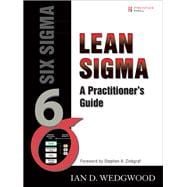The Practical, Easy-to-Use Guide to Lean Sigma Problem-Solving
Lean Sigma delivers results—if you use the right tools and techniques. In Lean Sigma: A Practitioner’s Guide, Dr. Ian Wedgwood captures best-practice Lean Sigma experience from multiple projects and industries, helping any professional identify the solution that will work best—and implement it.
Wedgwood’s exclusive "project roadmaps" present the fastest, most effective route to solving a wide range of problems—and explain why those solutions make sense. His "discovery roadmaps" help you identify potential Lean Sigma projects, even in processes where there are no obvious targets.
The heart of Lean Sigma is Wedgwood's 48 individual "tools roadmaps": step-by-step instructions revealing exactly how and when to use all these Lean Sigma tools...
| • 5 Whys
| • 5S
|
| • Affinity
| • ANOVA
|
| • Boxplots
| • Capability tools
|
| • Cause & effect matrices
| • Chi-Square
|
| • Control charts
| • Critical path analyses
|
| • Customer tools
| • Demand tools
|
| • DOE tools
| • Fishbone diagrams
|
| • Handoff maps
| • KPOVs
|
| • Load charts
| • MSA tools
|
| • Multi-Cycle analyses
| • Multi-Vari studies
|
| • Murphy’s analyses
| • Normality tests
|
| • OEE
| • Pareto charts
|
| • Poka Yoke
| • Process FMEA
|
| • Process variables (I/O) maps
| • Project charter
|
| • Pull systems & Kanban
| • Rapid changeover
|
| • Regression
| • SIPOC
|
| • Spaghetti maps
| • SPC
|
| • Swimlane maps
| • Time tools
|
Whether you’re a Green Belt, Black Belt, Master, Project Champion, Sponsor, Deployment Leader, or consultant, this book will help you use Lean Sigma to solve far more problems, far more rapidly, and far more effectively.
Dr. Ian Wedgwood, Executive Director of Sigma Breakthrough Technologies, has more than ten years of experience using, deploying, training, and consulting on Six Sigma and Lean Sigma. He has led and facilitated deployments in industries ranging from electronics and medical devices to chemicals and health care, and has trained and mentored numerous executives, champions, and belts. He holds a Ph.D. and First-Class Honors degree in Applied Mathematics from Scotland’s St. Andrew’s University.
Chapter 1 Introduction 1
PART I PROJECT ROADMAPS TO SOLVE BUSINESS PROBLEMS
Chapter 2 Define—Tools Roadmap Applied to the Beginning of All Projects 13
Chapter 3 Global Process Problems 23
A: On-Time Delivery Issues 23
B: Capacity of Process Is Too Low 27
C: RTY, Defects, Accuracy, Quality, Scrap, and Rework Issues 29
D: % Uptime Is Too Low 33
E: Pace of Process Too Slow 36
F: Process Has Enough Capacity, But Fails Intermittently 38
G: Process Has Enough Capacity, But Process Lead Time Is Too Long 41
H: Individual Steps Meet Takt, Global Process Does Not 44
I: Demand from the Customer Is Too Variable 47
J: Too Many Entity Types (Products) 51
K: High Schedule Variation 54
L: Measurement System Broken 60
M: Pe








